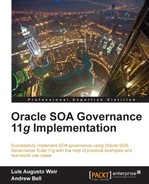This chapter will cover a high-level architecture of the product, the different software components that are part of the product architecture, and the core concepts and capabilities available in Oracle Enterprise Repository. The chapter also describes concepts such as managed Asset visibility using Oracle Enterprise Repository Solution Packs, such as the Harvester Solution Pack and the Base Data Pack.
Oracle Enterprise Repository (OER) is Oracle's flagship product for supporting the design-time Governance aspects of the Oracle SOA Governance solution. The runtime components of the solution integrate with OER to provide data for metrics such as service usability and service re-use, providing important information to assist with the design-time decisions.
OER delivers critical information to architects, SOA designers, and developers at design time to empower them to make more informed decisions when designing services. For example, determining if there are opportunities for service re-use rather than create new ones when updating a service catalogue, or determining if there is a risk of a service being overused.
The repository also provides vital information to business analysis and business architects about the available capabilities. This can be extremely useful when, for example, elaborating a process model that can benefit from existing capabilities, such as to submit a purchase order, search a customer database, or address validation.
OER is feature-rich with access to features configured, based on the roles. This allows organizations to implement existing Role Based Access Control (RBAC) models and therefore limit access to Assets based on user role.
In OER an Asset is any document, piece of code (XML, Java, or any other programming language or notation), or any other electronic document that can be considered to add value to an SOA implementation. For example, the following Asset relationship model describes the different types of Assets that are usually related to an SOA service. OER is capable of harvesting different sources and subsequently building up an Asset relationship view similar to the diagram:

OER allows for Assets that have been harvested to undergo an approval workflow using an in-built Asset workflow module. During this approval process, design-time policies can be enforced. For example, Assets that comply with existing policies can be accepted while those that do not can be rejected. Approvers in the lifecycle process can upload documents to provide evidence in support of their decisions. Furthermore, consumers of the Assets can reference information to assist in the decision to use a particular service.
Some of the features that are available within OER to support the service lifecycle are:
- Direct integration with IDEs (such as JDeveloper and Eclipse) allowing the prescription of Assets for new projects and the easy browsing and consumption of existing Assets
- An Asset Harvester that automatically populates OER with SOA Assets and tracks updates to artifacts automatically
- A built-in process engine with a set of standard processes that can be modified to meet organizations' governance process workflows
- Built-in automated notification on a selection of lifecycle events, plus discretionary notification of Asset subscribers
- An event engine that can publish repository events to any process service endpoint
- A bi-directional registry exchange feature that keeps information synchronized between the enterprise repository and the service registry
- A rich SOAP-based API that allows organizations to programmatically update the repository, keeping it in sync with the IT and business environment that it describes
- Summary of runtime performance metrics from runtime environments
- Rich Analytics features such as the amount of re-use of services in the entire lifecycle, compliance scorecards, and runtime performance metrics
In summary, OER enhances Design Time Governance and allows for policies to enforce on services from the moment of conception, through design, development, and rollout stages of a project. Furthermore the ability to feed OER with runtime metrics (such as service utilization and degree of re-use) together with the rich reporting features helps architects to provide tangible evidence of the ROI for all services.
